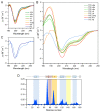Cellular Chaperone Function of Intrinsically Disordered Dehydrin ERD14
- PMID: 34201246
- PMCID: PMC8230022
- DOI: 10.3390/ijms22126190
Cellular Chaperone Function of Intrinsically Disordered Dehydrin ERD14
Abstract
Disordered plant chaperones play key roles in helping plants survive in harsh conditions, and they are indispensable for seeds to remain viable. Aside from well-known and thoroughly characterized globular chaperone proteins, there are a number of intrinsically disordered proteins (IDPs) that can also serve as highly effective protecting agents in the cells. One of the largest groups of disordered chaperones is the group of dehydrins, proteins that are expressed at high levels under different abiotic stress conditions, such as drought, high temperature, or osmotic stress. Dehydrins are characterized by the presence of different conserved sequence motifs that also serve as the basis for their categorization. Despite their accepted importance, the exact role and relevance of the conserved regions have not yet been formally addressed. Here, we explored the involvement of each conserved segment in the protective function of the intrinsically disordered stress protein (IDSP) A. thaliana's Early Response to Dehydration (ERD14). We show that segments that are directly involved in partner binding, and others that are not, are equally necessary for proper function and that cellular protection emerges from the balanced interplay of different regions of ERD14.
Keywords: CD spectroscopy; LEA protein; dehydrin; early response to dehydration; heat stress; intrinsic structural disorder; plant chaperone; structure-function relationship.
Conflict of interest statement
The authors declare no conflict of interest.
Figures





Similar articles
-
Interplay of Structural Disorder and Short Binding Elements in the Cellular Chaperone Function of Plant Dehydrin ERD14.Cells. 2020 Aug 7;9(8):1856. doi: 10.3390/cells9081856. Cells. 2020. PMID: 32784707 Free PMC article.
-
Dehydrin ERD14 activates glutathione transferase Phi9 in Arabidopsis thaliana under osmotic stress.Biochim Biophys Acta Gen Subj. 2020 Mar;1864(3):129506. doi: 10.1016/j.bbagen.2019.129506. Epub 2019 Dec 20. Biochim Biophys Acta Gen Subj. 2020. PMID: 31870857
-
Full backbone assignment and dynamics of the intrinsically disordered dehydrin ERD14.Biomol NMR Assign. 2011 Oct;5(2):189-93. doi: 10.1007/s12104-011-9297-2. Epub 2011 Feb 19. Biomol NMR Assign. 2011. PMID: 21336827
-
Plant Group II LEA Proteins: Intrinsically Disordered Structure for Multiple Functions in Response to Environmental Stresses.Biomolecules. 2021 Nov 9;11(11):1662. doi: 10.3390/biom11111662. Biomolecules. 2021. PMID: 34827660 Free PMC article. Review.
-
The Disordered Dehydrin and Its Role in Plant Protection: A Biochemical Perspective.Biomolecules. 2022 Feb 11;12(2):294. doi: 10.3390/biom12020294. Biomolecules. 2022. PMID: 35204794 Free PMC article. Review.
Cited by
-
Intrinsically Disordered Proteins: An Overview.Int J Mol Sci. 2022 Nov 14;23(22):14050. doi: 10.3390/ijms232214050. Int J Mol Sci. 2022. PMID: 36430530 Free PMC article. Review.
-
Protein Disorder in Plant Stress Adaptation: From Late Embryogenesis Abundant to Other Intrinsically Disordered Proteins.Int J Mol Sci. 2024 Jan 18;25(2):1178. doi: 10.3390/ijms25021178. Int J Mol Sci. 2024. PMID: 38256256 Free PMC article. Review.
-
The Moonlighting Function of Soybean Disordered Methyl-CpG-Binding Domain 10c Protein.Int J Mol Sci. 2023 May 12;24(10):8677. doi: 10.3390/ijms24108677. Int J Mol Sci. 2023. PMID: 37240035 Free PMC article.
-
General Characterization of Properties of Ordered and Disordered Proteins by Wide-Line 1H NMR.ACS Omega. 2024 May 22;9(22):23468-23475. doi: 10.1021/acsomega.4c00517. eCollection 2024 Jun 4. ACS Omega. 2024. PMID: 38854569 Free PMC article.
-
Disordered-Ordered Protein Binary Classification by Circular Dichroism Spectroscopy.Front Mol Biosci. 2022 May 3;9:863141. doi: 10.3389/fmolb.2022.863141. eCollection 2022. Front Mol Biosci. 2022. PMID: 35591946 Free PMC article.
References
-
- Storey J.M., Storey K.B. Sensing, Signaling and Cell Adaptation. Elsevier; Amsterdam, The Netherlands: 2002.
MeSH terms
Substances
Grants and funding
- G.0029.12/Research Foundation Flanders
- 2010-88343/Korea Research Council of Fundamental Science and Technology
- NTM2231712/National Research Council of Science and Technology
- K124670/National Research, Development and Innovation Office, Hungary
- K131702/National Research, Development and Innovation Office, Hungary
- K125340/National Research, Development and Innovation Office, Hungary
- K120391/National Research, Development and Innovation Office, Hungary
- KH125597/National Research, Development and Innovation Office, Hungary
- PD135510/National Research, Development and Innovation Office, Hungary
- Bolyai János Scholarship/Hungarian Academy of Sciences
- 20171582/SOLEIL Synchrotron, France
- 20180805/SOLEIL Synchrotron, France
- 20181890/SOLEIL Synchrotron, France
- Lendület Grant/Hungarian Academy of Sciences
LinkOut - more resources
Full Text Sources

